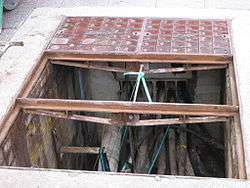Manhole
A manhole (alternatively utility hole, maintenance hole[1], or sewer hole) is an opening to a confined space such as a shaft, utility vault, or large vessel. Manholes are often used as an access point for an underground public utility, allowing inspection, maintenance, and system upgrades. The majority of underground services have manholes, including water, sewers, telephone, electricity, storm drains, district heating, and gas.



Manholes are generally found in urban areas, in streets and occasionally under sidewalks. In rural and undeveloped areas, services such as telephone and electricity are usually carried on utility poles or even pylons rather than underground.
In Australia, manhole also commonly refers to an access hatch used to get access from a room or hallway into the ceiling cavity of a building.[2][3] These manholes are typically around 450 mm × 450 mm (18 in × 18 in) square.
Construction
Manhole closings are protected by a grating or manhole cover, a flat plug designed to prevent accidental or unauthorized access to the manhole. These covers are traditionally made of metal, but may be constructed from precast concrete, glass reinforced plastic or other composite materials (especially where cover theft is of concern). Because of legislation restricting acceptable manual handling weights, Europe has seen a move toward lighter-weight composite manhole cover materials, which also have the benefits of greater slip resistance and electrical insulating properties.
Manholes are usually outfitted with metal, polypropylene, or fiberglass steps installed in the inner side of the wall to allow easy descent into the utility space.
Manholes are usually round, primarily because roundness is the best shape to resist the compression of the earth; covers are round because they are easier to manufacture than square or rectangular shapes, they are easier to move by rolling, and they can't fall into the opening.[4] But in the United Kingdom they are nearly always square, or rectangular, in shape, at least at street level. Manholes can also be found in a triangular shape (e.g. in Cambridge, UK, and surrounding villages).
Composite manholes
Composite (fiberglass) manholes are commonly used in applications where infiltration, exfiltration, or corrosion by hydrogen sulfide (from sewer gas) are a concern, or where structures need to be factory integrated into a manhole before placement. In these manholes, the entire underground enclosure is constructed of some composite material, in addition to the cover.
Structures that can be integrated into composite manholes include:
Hazards caused by stray voltage in manholes
In urban areas, stray voltage issues have become a significant concern for utilities. In 2004, Jodie S. Lane was electrocuted after stepping on a metal manhole cover, while walking her dog in New York City.[11]
Gallery
- Manhole cover in Belo Horizonte, Brazil
 Manhole cover in Sawston, Cambridgeshire
Manhole cover in Sawston, Cambridgeshire
 Manhole cover of precast concrete in Germany
Manhole cover of precast concrete in Germany Storm drain manhole without cover in France
Storm drain manhole without cover in France "Man Hole Door" at Girard College, Philadelphia, constructed in the 1840s
"Man Hole Door" at Girard College, Philadelphia, constructed in the 1840s- An open packaged metering manhole made of fiberglass before installation
 Manhole cover in Kibbutz Sasa, Israel
Manhole cover in Kibbutz Sasa, Israel
See also
- Manhole cover
- Packaged Metering Manhole

References
- Nemerow, Nelson L.; Agardy, Franklin J.; Salvato, Joseph A. (2009). Environmental Engineering: Environmental Health and Safety for Municipal Infrastructure, Land Use and Planning, and Industry (6, illustrated ed.). John Wiley & Sons. ISBN 978-0470083055. Retrieved 2019-07-19.
- Attribus Innovation (17 January 2019). "Assessment Requirements for CPCCPB3027 Install ceiling insulation products" (PDF). Department of Education and Training (1st ed.). Commonwealth of Australia. Retrieved 5 July 2019.
- "How to install a manhole". Bunnings Warehouse. Retrieved 5 July 2019.
- Scheckel, Larry (December 2013). Ask a Science Teacher: 250 Answers to Questions You've Always Had About How Everyday Stuff Really Works. The Experiment. ISBN 9781615190874.
- "Manhole inverts" (PDF). Containment Solutions. Archived from the original (PDF) on 2015-04-03. Retrieved 2013-03-07.
- "Packaged Fiberglass (FRP) Flume Manholes". Openchannelflow. Archived from the original on 2013-03-25.
- "Packaged Fiberglass (FRP) Weir Manholes for Flow Monitoring". Openchannelflow. Archived from the original on 2013-09-19.
- "Fiberglass (FRP) Storm Water Manholes for Initial Oil, Grease, Sediment, and Debris Collection". Openchannelflow. Archived from the original on 2013-03-07.
- "Fiberglass (FRP) Grinder Manholes integrating grinders from JWC, Franklin Miller, MonoFlo, and more". Openchannelflow. Archived from the original on 2013-08-28.
- "Fiberglass Energy Absorbing Manholes for Controlling Excess Line Velocities". Openchannelflow. Archived from the original on 2013-03-07.
- Ramirez, Anthony (January 19, 2004). "East Village Woman Was Electrocuted on Street With Metal Plate, Medical Examiner Says". New York Times. Retrieved 2009-12-03.
- Isles, Paul (2010). "Dover Engineering Works". Dover Life Magazine
Further reading
- Ascher, Kate; Marech, Wendy (2007). The works: anatomy of a city. New York: Penguin Press. ISBN 978-0-14-311270-9.